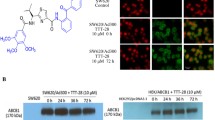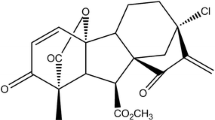Abstract
Multidrug resistance (MDR) is one of the main obstacles in tumor chemotherapy. A promising approach to solving this problem is to utilize a nontoxic and potent modulator able to reverse MDR, which in combination with anticancer drugs increases the anticancer effect. Experiments were carried out to examine the potential of tetrandrine (Tet) as a MDR-reversing agent. Survival of cells incubated with Tet at 2.5 μmol/l for 72 h was over 90%. Tet at 2.5 μmol/l almost completely reversed resistance to vincristine (VCR) in KBv200 cells. Tet at a concentration as low as 0.625 μmol/l produced a 7.6-fold reversal of MDR, but showed no effect on the sensitivity of drug-sensitive KB cells in vitro. In the KBv200 cell xenograft model in nude mice, neither Tet nor VCR inhibited tumor growth. However, VCR and Tet combined inhibited tumor growth by 45.7%, 61.2% and 55.7% in three independent experimental settings. In the KB cell xenograft model in nude mice, Tet did not inhibit tumor growth, but VCR and the combination of VCR and Tet inhibited tumor growth by 40.6% and 41.6%, respectively. Mechanism studies showed that Tet inhibited [3H]azidopine photoaffinity labeling of P-gp and increased accumulation of VCR in MDR KBv200 cells in a concentration-dependent manner. The results suggest that Tet is a potent MDR-reversing agent in vitro and in vivo. Its mechanism of action is via directly binding to P-gp and increasing intracellular VCR accumulation.







Similar content being viewed by others
Abbreviations
- DMSO:
-
Dimethyl sulfoxide
- FBS:
-
Fetal bovine serum
- MDR:
-
Multidrug resistance
- MTT:
-
3-(4,5-Dimethylthiazol-yl)-2,5-diphenyltetrazolium bromide
- PBS:
-
Phosphate-buffered saline
- P-gp:
-
P-glycoprotein
- SDS:
-
Sodium dodecyl sulfate
- Tet:
-
Tetrandrine
- VCR:
-
Vincristine
References
Atadja P, Watanabe T, Xu H, Cohen D (1998) PSC-833, a frontier in modulation of P-glycoprotein mediated multidrug resistance. Cancer Metastasis Rev 17:163–168
Carmichael J, DeGraff WG, Gazadar AF, Minna JD, Mitchell JB (1987) Evaluation of a tetrazolium-based semiautomated colorimetric assay: assessment of chemosensitivity testing. Cancer Res 47:943–946
Chen ZS, Kawabe T, Ono M, Aoki S, Sumizawa T, Furukawa T, Uchiumi T, Wada M, Kuwano M, Akiyama SI (1999) Effect of multidrug resistance-reversing agents on transporting activity of human canalicular multispecific organic anion transporter. Mol Pharmacol 56:1219–1228
Dantzig AH, Shepard RL, Cao J, Law KL, Ehlhardt WJ, Baughman TM, Bumol TF, Starling JJ (1996) Reversal of P-glycoprotein-mediated multidrug resistance by a potent cyclopropyldibenzosuberane modulator, LY335979. Cancer Res 56:4171–4179
Fang JH, Fang YH (1996) Tetrandrine: pharmacology and clinical usefulness. Chin Pharm J 31:454–457
Fu LW, Pan QC (1996) The properties shared by compounds with reversing tumor multidrug resistance. Chin J Cancer 15:475–477
Fu LW, He LR, Liang YJ, Chen LM, Xiong HY, Yang XP, Pan QC (2003) Experimental chemotherapy against xenografts derived from multidrug resistant KBv200 cells and parental drug-sensitive KB cells in nude mice by annonaceous acetogenin 89-2. Yao Xue Xue Bao 38:565–570
Germann UA, Shlyakhter D, Mason VS, Zelle RE, Duffy JP, Galullo V, Armistead DM, Saunders JO, Boger J, Harding MW (1997) Cellular and biochemical characterization of VX-710 as a chemosensitizer: reversal of P-glycoprotein-mediated multidrug resistance in vitro. Anticancer Drugs 8:125–140
Hyafil F, Vergely C, Du Vignaud P, Grand-Perret T (1993) In vitro and in vivo reversal of multidrug resistance by GF120918, an acridonecarboxamide derivative. Cancer Res 53:4595–4602
Krishna R, Mayer LD (2000) Multidrug resistance (MDR) in cancer. Mechanisms, reversal using modulators of MDR and the role of MDR modulators in influencing the pharmacokinetics of anticancer drugs. Eur J Pharm Sci 11:265–283
Lawrence DS, Copper JE, Smith CD (2001) Structure-activity studies of substituted quinoxalinones as multiple-drug-resistance antagonists. J Med Chem 44:594–601
Lella JW (2001) Constructing history in biography: a symposium on William Osler: a life in medicine. Introduction. Bull Hist Med 75:740–744
Liang YJ, Fu Lw, Pan QC (2000) Establishment of the model of KBv200 nude mice xenograft and the studies on its characterization of multidrug resistance. Chin Pharmacol Bull 16:705–707
Ling V (1997) Multidrug resistance: molecular mechanisms and clinical relevance. Cancer Chemother Pharmacol [Suppl] 40:S3
Malayeri R, Filipits M, Suchomel RW, Zochbauer S, Lechner K, Pirker R (1996) Multidrug resistance in leukemias and its reversal. Leuk Lymphoma 23:451–458
May GL, Wright LC, Dyne M, Mackinnon WB, Fox RM, Mountford CE (1988) Plasma membrane lipid composition of vinblastine sensitive and resistant human leukaemic lymphoblasts. Int J Cancer 42:728–733
Motoji T, Motomura S, Wang YH (2000) Multidrug resistance of acute leukemia and a strategy to overcome it. Int J Hematol 72:418–424
Newman MJ, Rodarte JC, Benbatoul KD, Romano SJ, Zhang C, Krane S, Moran EJ, Uyeda RT, Dixon R, Guns ES, Mayer LD (2000) Discovery and characterization of OC144-093, a novel inhibitor of P-glycoprotein-mediated multidrug resistance. Cancer Res 60:2964–2972
Scheper RJ, Broxterman HJ, Scheffer GL, Kaaijk P, Dalton WS, van Heijningen TH, van Kalken CK, Slovak ML, de Vries EG, van der Valk P (1993) Overexpression of a M(r) 110,000 vesicular protein in non-P-glycoprotein-mediated multidrug resistance. Cancer Res 53:1475–1479
Sikic BI (1997) Pharmacologic approaches to reversing multidrug resistance. Semin Hematol 34 [4 Suppl 5]:40–47
Sikic BI, Fisher GA, Lum BL, Halsey J, Beketic-Oreskovic L, Chen G (1997) Modulation and prevention of multidrug resistance by inhibitors of P-glycoprotein. Cancer Chemother Pharmacol [Suppl] 40:S13–19
Starling JJ, Shepard RL, Cao J, Law KL, Norman BH, Kroin JS, Ehlhardt WJ, Baughman TM, Winter MA, Bell MG, Shih C, Gruber J, Elmquist WF, Dantzig AH (1997) Pharmacological characterization of LY335979: a potent cyclopropyldibenzosuberane modulator of P-glycoprotein. Adv Enzyme Regul 37:335–347
Sumizawa T, Chen ZS, Chuman Y, Seto K, Furukawa T, Haraguchi M, Tani A, Shudo N, Akiyama SI (1997) Reversal of multidrug resistance-associated protein-mediated drug resistance by the pyridine analog PAK-104P. Mol Pharmacol 51:399–405
Szabo D, Keyzer H, Kaiser HE, Molnar J (2000) Reversal of multidrug resistance of tumor cells. Anticancer Res 20:4261–4274
Tranchand B, Catimel G, Lucas C, Sarkany M, Bastian G, Evene E, Guastalla JP, Negrier S, Rebattu P, Dumortier A, Foy M, Grossin F, Mazier B, Froudarakis M, Barbet N, Clavel M, Ardiet C (1998) Phase I clinical and pharmacokinetic study of S9788, a new multidrug-resistance reversal agent given alone and in combination with doxorubicin to patients with advanced solid tumors. Cancer Chemother Pharmacol 41:281–291
Tsuruo T, Iida H, Tsukagoshi S, Sakurai Y (1981) Overcoming of vincristine resistance in P388 leukemia in vivo and in vitro through enhanced cytotoxicity of vincristine and vinblastine by verapamil. Cancer Res 41:1967–1972
van den Heuvel-Eibrink MM, Sonneveld P, Pieters R (2000) The prognostic significance of membrane transport-associated multidrug resistance (MDR) proteins in leukemia. Int J Clin Pharmacol Ther 38:94–110
Volm M (1998) Multidrug resistance and its reversal. Anticancer Res 18:2905–2917
Wiese M, Pajeva IK (2001) Structure-activity relationships of multidrug resistance reversers. Curr Med Chem 8:685–713
Wigler PW (1996) Cellular drug efflux and reversal therapy of cancer. J Bioenerg Biomembr 28:279–284
Zhang XH, Zhang FY, Ji XJ, Li ZY (1994) Vincristine-resistant human KB cell line and mechanism of multidrug resistance. Yao Xue Xue Bao 29:246–251
Acknowledgements
We would like to thank Prof. Y.S. Liu (Chinese Academy of Medical Sciences, Beijing) for providing the KB and KBv200 cell lines, Dr. X.P. Pan (Kuming Institute of Botany, Chinese Academy of Sciences) for providing the tetrandrine. This work was supported in part by a Key Science and Technology Project Research Grant of Guangdong Province (no. 990B82), a grant from the Natural Science Foundation of Guangdong Province (no. 9800104) and an Excellent Youth Grant from the Ministry of Health (no. 9905), P. R. China.
Author information
Authors and Affiliations
Corresponding author
Rights and permissions
About this article
Cite this article
Fu, L., Liang, Y., Deng, L. et al. Characterization of tetrandrine, a potent inhibitor of P-glycoprotein-mediated multidrug resistance. Cancer Chemother Pharmacol 53, 349–356 (2004). https://doi.org/10.1007/s00280-003-0742-5
Received:
Accepted:
Published:
Issue Date:
DOI: https://doi.org/10.1007/s00280-003-0742-5




